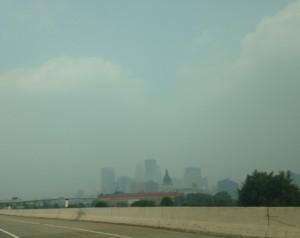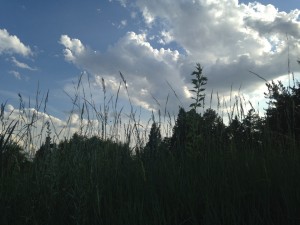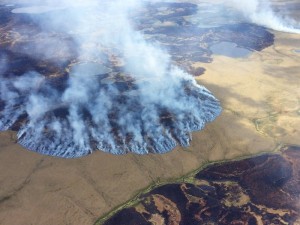
I was born and raised in northern Minnesota. In a place where it can (and does) snow eight or nine months of the year, weather is not just small talk. Even when I call my parents, weather is one of the first subjects we catch up on. So, for the past few weeks, I’ve heard constant comments on the “Canadian wildfire haze” in our conversations. Wildfires across western Canada have sent a smoky haze across much of the United States for the past month. And although it was initially heaviest in the Midwest and East (at one point, the entirety of Minnesota was under an air alert), the smoke reached Colorado in early July.
This was in the back of my mind when I visited the Denver Botanic Gardens, in search of global clues within natural art. I found it in the Laura Smith Porter Plains Garden. It includes a variety of grasses, with signage indicating which types and lengths of grasses are found in areas across the United States. Compared to the intricately designed Japanese Garden or the rising hedges of the O’Fallon Perennial Walk, the Plains Garden seems unassuming at first. Much like the Great Plains, however, the landscape design makes it seem to extend past the horizon, evoking the feeling of endlessness. It’s one of the most subtle sections in the gardens, which is why I think I had so much appreciation for it.

I already knew this was something I wanted to write about, and the window to the rest of the world opened pretty quickly when I spotted a sign: “Many ecosystems depend upon the rejuvenating effects of periodic, naturally-caused fires. Native Americans set fires in late winter to amplify the natural process. At Denver Botanic Gardens, we replicate this process with a controlled burn every 3-4 years, closely imitating natural cycles.” The images of a smoke-covered Minnesota rushed into my head, aided by a text message from my parents including a picture of their patio dinner, haze over the horizon. A few days later, smoke appeared over Denver, amplifying my desire to examine the implications of wildfires across the globe. This time, let’s take a step forward.

The severity of the current Canadian (and Alaskan) wildfires is unprecedented, much like the Colorado wildfires of 2013. In the case of Alaska, this fire has entered record territory. These fires aren’t just freak incidents, though. The annual area burned by wildfires in Canada since the ‘70s has, on average, doubled. In fact, wildfire seasons worldwide have increased by 25.3 percent, with all continents but Australia and Antarctica seeing more wildfires annually. Wildfires are becoming a greater issue worldwide. Many of these fires occur in forests, unlike the controlled burns of the Plains Garden. Additionally, they are becoming an increasing detriment to their surrounding ecosystem – unlike the healthy controlled burns at the Botanic Gardens.
Wildfires tend to favor hot and dry conditions. It may cause no surprise, then, to see that the increase in wildfires and their severity is connected to climate change. Although global warming can have different effects on different parts of the world, it has increased hot and dry conditions where wildfires are already prominent. Additionally, wildfires contribute to a positive feedback cycle. More severe wildfires are more likely to create brown and black carbon smoke, which increase global warming conditions. Controlled burns, like those that clean the Plains Garden, aren’t likely to release brown and black carbon that increase global warming. This is an important distinction between the planned burning at the Botanic Gardens and the increasingly severe wildfires across the world.
Fortunately, our ability to handle wildfires has improved greatly since the establishment of national forestry services in the early 20th century. Wildfires are much less of a risk to human life, but there are still significant possibilities for economic and lifestyle damages, outside of their contribution to climate change. In the Canadian wildfires, 86 homes have been destroyed and about 13,000 people have evacuated. International firefighters and Canadian armed forces have been called in to help suppress the fires. Had these fires occurred in a more populous region or in a country with fewer firefighting resources, these damages could have been much worse. From the changes in wildfire seasons that have already occurred, it seems that those damages will increase and human life may be at risk once again. Again, the controlled burns at the Botanic Gardens are a healthy part of the plains ecological cycle, with little life and economic risk. However, increasingly severe wildfires will soon (if not already) burn more than what is necessary for the ecological cycle and are increasingly harmful to the environment.

Wildfires are just one example of how global change in climate can affect local areas and push healthy ecological systems to the point of detriment. Although the Laura Smith Porter Plains Garden isn’t at great risk of destructive wildfires, the plains it replicate may be in the future. Additionally, we can already see the effects wildfire (and its smoke) can have across an entire continent. In fact, the image of a smoky haze covering the Denver Botanic Gardens may be one that we will have to get used to seeing in the next 20 years.

